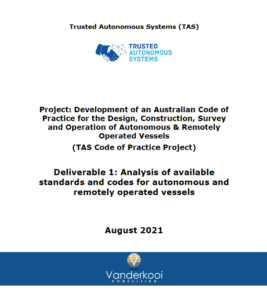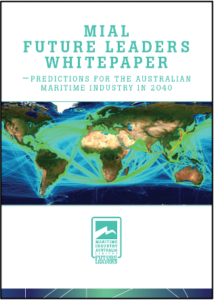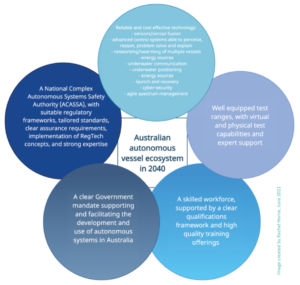Rachel Horne, Assurance of Autonomy Activity Lead, Trusted Autonomous Systems (TAS)
 Autonomous systems offer the ability to increase safety and efficiency while lowering environmental and economic costs. In the last five years, there has been a rapid acceleration in the capacity and availability of autonomous and remotely operated vessels. Autonomous systems need to be trusted by government, regulators, operators and the broader community if this rapid acceleration is to continue and to ensure this technology can integrate into commercial and defence operations. An integral part of gaining trust is having consistent assurance requirements, and a clear, tailored regulatory framework.
Autonomous systems offer the ability to increase safety and efficiency while lowering environmental and economic costs. In the last five years, there has been a rapid acceleration in the capacity and availability of autonomous and remotely operated vessels. Autonomous systems need to be trusted by government, regulators, operators and the broader community if this rapid acceleration is to continue and to ensure this technology can integrate into commercial and defence operations. An integral part of gaining trust is having consistent assurance requirements, and a clear, tailored regulatory framework.
The Queensland Government has identified the safety, environmental, and economic opportunities of addressing the assurance and accreditation challenges for autonomous systems, resulting in funding for the Assurance of Autonomy Activity through Trusted Autonomous Systems (TAS)[1]. This Activity: “…aims to unlock Queensland’s, and by extension Australia’s, capacity for translating autonomous system innovation into operational capability, leveraging regulatory and technical expertise and strong stakeholder relationships to support industry and regulators.”[2]
To support the development of a clear, tailored, regulatory framework, TAS is leading the development of an Australian Code of Practice for the Design, Construction, Survey and Operation of Autonomous and Remotely Operated Vessels (Australian Code of Practice), supported by Maaike Vanderkooi of Vanderkooi Consulting. The Australian Code of Practice will represent best practice and is intended to provide certainty for industry by providing clear standards, tailored for the type of vessels and operations common in Australia. The Australian Code of Practice will be voluntary and will be updated periodically. It is hoped that the Australian Maritime Safety Authority (AMSA), which has been closely consulted throughout this project, will recognise the Code and in the future consider incorporating it into their regulatory framework.
There are several codes, standards, and guidelines already available internationally for autonomous and remotely operated vessels. The first step in the development of an Australian Code of Practice is understanding the leading existing codes, standards and guidelines, considering them in an Australian context, and then determining whether any of these documents, or specific approaches they take, could be tailored for use in an Australian context. Recognising the importance of this step, TAS engaged Maaike Vanderkooi of Vanderkooi Consulting to prepare a Report (“Analysis of Available Standards and Codes for Autonomous and Remotely Operated Vessels”), as the first stage in the project to develop the Australian Code of Practice.
Report: Analysis of Available Standards and Codes for Autonomous and Remotely Operated Vessels
The Report analyses:
- the UK Code of Practice for Maritime Autonomous Surface Ships[3];
- the LR Code for Unmanned Marine Systems[4]; and
- DNV GL’s Autonomous and Remotely-operated Ships Class Guideline[5].
As part of the analysis of these documents, the Report seeks to:
- understand the structure and requirements of each of the codes;
- identify the differences and similarities between the codes; and
- consider the codes in the Australian regulatory context.
The below is extracted from pages 81-82 of the Report
“The report finds that:
- an Australian Code of Practice for autonomous and remotely operated vessels should align with the regulatory framework that already exists for conventional domestic vessels;
- the three available codes focus largely on vessels which comply with international conventions or Class Rules; and
- this is different to the context for an Australian Code of Practice, which will be tailored towards commercial vessels operating only in Australian waters.
For this reason, none of the available codes and standards considered in this report provide a template that could be tailored for use in Australia with only minor modifications.
However, each of the three available codes will significantly influence the content of the Australian code. This report uses the analysis of the three available codes and standards to identify the standards or requirements that should apply to autonomous vessels, beyond the requirements of conventional vessel standards. This will include tailored requirements for:
- situational awareness;
- control systems;
- software integrity and testing; and
- safe states.
This report also finds that the operational requirements that apply to conventional vessels in Australia should apply to autonomous and remotely operated vessels, with some differences:
- the safety management system requirements need to be tailored to autonomous and remote vessel operations;
- the minimum crew and crew competency requirements will need to be modified; and
- there will be additional requirements for contingency planning and control hierarchies, which should be informed by the content of the three available codes and standards.
In line with the available codes and standards, a risk analysis approach, which focuses on the impact of potential failures, should apply to the development and testing of novel systems on the vessel, including the systems for situational awareness and control and all systems which do not meet the requirements of the conventional vessel standards.
Finally, this report notes that the baseline requirement of each of the available codes and standards is for an autonomous or remotely operated vessel to be ‘as safe as’ a conventional vessel. Given that the scope of the Australian code will include very small, low risk autonomous marine equipment, whether or not this baseline approach is appropriate for all vessels subject to the Australian code will need to be considered as part of the consultation process on the development of the Australian code.”
Since this report has been completed, the project has identified the underpinning principles for the draft Australian Code of Practice, using stakeholder consultation to refine and ensure they are fit for purpose[6] (complete) and drafted the Australian Code of Practice (complete).
Next steps
| 1. Undertake consultation on the draft Australian Code of Practice with the Australian Maritime Safety Authority (underway);
2. Undertake public consultation on the draft Australian Code of Practice to ensure it is fit for purpose and will be as useful as possible for Australian industry (expected mid-November 2021); and
3. Finalise and release edition one of the Australian Code of Practice with accompanying guidance material (expected early 2022). |
TAS intends to release edition one of the Australian Code of Practice with accompanying guidance material via our website and it will likely also appear directly on AMSA’s website. Feedback on the Australian Code of Practice can be provided directly to either TAS or AMSA to inform continued iterative development.
If you would like to contact us in relation to the TAS Code of Practice project, to offer feedback, suggestions, or request more information, please email us at info@tasdcrc.com.au.
[1] Trusted Autonomous Systems, 2021, Assurance of Autonomy Activity
[2] Trusted Autonomous Systems, 2021, Assurance of Autonomy Activity
[3] Maritime UK, 2020, Being a Responsible Industry, Maritime Autonomous Ship Systems (MASS) UK Industry Conduct, Principles and Code of Practice, A Voluntary Code (Version 4)
[4] Lloyd’s Register, 2017, LR Code for Unmanned Marine Systems
[5] DNV GL, 2018, DNV class guidelines: Autonomous and remotely operated ships, DNVGL-CG-0264
[6] Information on these principles and the consultation undertaken available here: Vanderkooi, M. and Horne, R., 2021, Outcomes of a successful webinar on TAS’s project to develop an Australian Code of Practice in 2021










